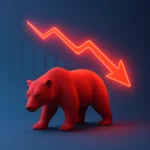The Rounding Top Pattern: The Ultimate Guide For Beginner Traders

Back when I first started trading, I was riding high on a streak of small wins. I thought I had cracked the code. One day, I came across a stock that had been on an uptrend for months. It looked stable, the volume was decent, and the trend seemed unstoppable. But then, something strange happened. The uptrend started slowing down. The chart began to form a gentle curve. I ignored it.
Table Of Content
- What is a Rounding Top Pattern?
- Key Characteristics
- Psychology Behind the Rounding Top Pattern
- Components of the Rounding Top Pattern
- 1. Prior Uptrend
- 2. Advance Phase
- 3. Formation of the Top (Peak)
- 4. Decline Phase
- 5. Breakdown (Neckline Break)
- 6. Volume Behaviour
- 7. Target Price Calculation
- 8. Stop-Loss Placement
- Exhibits
- Real-World Analogy
- How to Trade the Rounding Top Pattern
- Common Mistakes Beginners Make
- 1. Jumping In Too Early
- 2. Ignoring Volume
- 3. Confusing with Other Patterns
- 4. No Stop-Loss Plan
- Real-World Examples
- 1. Tesla Inc. (TSLA)
- 2. Bitcoin (BTC)
- 3. NIFTY 50 Index
- 4. The Dot-Com Bust
- Beginner Tips to Spot the Rounding Top
- Trading Strategies Using the Rounding Top Pattern
- 1. Entry Point
- 2. Stop-Loss Placement
- 3. Profit Target
- Backtesting and Success Rate
- FAQs: Rounding Top Pattern
- What timeframe works best for spotting a rounding top?
- Is a rounding top pattern always a sign to short the stock?
- Can rounding tops fail?
- How long does it take for a rounding top to form?
- What indicators can help confirm the pattern?
- Is the rounding top pattern common?
- Can I use the pattern in crypto or forex?
- What is the rounding top pattern?
- How can I identify a rounding top pattern?
- Is the rounding top pattern applicable to all markets?
- What is the significance of volume in the rounding top pattern?
- How can I set a profit target when trading the rounding top pattern?
- Can the rounding top pattern lead to false signals?
- How long does it take for a rounding top pattern to form?
Two weeks later, the price plummeted.
What I had missed was a classic rounding top pattern forming in front of my eyes. Had I known what to look for, I would have exited my position early, saving both capital and confidence. If you’re new to trading, learning to identify this powerful bearish reversal pattern can protect your portfolio from similar disasters.
What is a Rounding Top Pattern?

The rounding top pattern is a bearish reversal chart formation that looks like an inverted “U” or a saucer turned upside-down. It typically forms after a sustained uptrend and signals a shift in momentum from buyers to sellers.
Also known as a saucer top, this pattern reflects gradual weakening in bullish sentiment, leading to a potential trend reversal. It’s a favorite among technical analysts because it captures the psychology of a fading rally.
Key Characteristics:

- Formation: Begins with a strong uptrend, peaks with a rounded top, and transitions into a downtrend.
- Volume: Volume usually declines while the pattern is forming and rises sharply during the breakout.
- Duration: Can develop over weeks to months, depending on the asset and market conditions.
Psychology Behind the Rounding Top Pattern
The rounding top pattern reflects a gradual shift in market sentiment. Initially, optimism drives prices upward. As the asset reaches its peak, enthusiasm wanes, and indecision sets in. Eventually, pessimism takes over, leading to increased selling pressure and a price decline.
Components of the Rounding Top Pattern
To fully grasp the rounding top pattern, let’s explore its main parts and stages step by step.
1. Prior Uptrend
Every rounding top begins after a significant upward price movement. This bullish trend sets the stage for potential exhaustion.
2. Advance Phase
In this stage, the asset continues to climb, albeit more slowly. Sometimes, you might see choppy price action or reduced volatility, both indicating weakening buying pressure.

3. Formation of the Top (Peak)
The price starts curving downward after reaching a rounded peak. It could resemble an inverted “U”, a soft “M”, or even an inverted “V”. The peak is usually not sharp, making the pattern easy to overlook.

4. Decline Phase
This phase is the opposite of the advance phase. As the price begins to trend downward, selling pressure builds, and bearish sentiment takes hold. Sellers gradually gain control, pushing prices lower. Trading volume often starts to rise during this stage, reinforcing the downward momentum and confirming that the shift in market sentiment is gaining strength.

5. Breakdown (Neckline Break)
The pattern is confirmed when the price breaks below the support level, commonly referred to as the neckline. A decisive breakdown accompanied by increased volume serves as strong confirmation of the bearish reversal. This surge in volume indicates that sellers are firmly in control.
In some cases, the price may briefly retest the neckline, turning former support into resistance before continuing its downward move. This retest can offer a second entry point for traders looking to confirm the trend shift.

6. Volume Behaviour
- High volume during the initial uptrend
- Lower volume around the peak
- Increased volume during the decline
This U-shaped volume trend supports the price behavior, reinforcing the pattern’s reliability.
7. Target Price Calculation
To calculate a target after the breakdown, measure the vertical distance from the peak to the neckline. Subtract this from the breakdown point to estimate the potential downside.

8. Stop-Loss Placement
A logical stop-loss can be set just above the pattern’s high or above the most recent swing high, especially if the price has fluctuated near the neckline.
Exhibits



Real-World Analogy
Imagine a party that’s been going strong for hours. People are lively, music is loud, and the energy is high (uptrend). Gradually, guests start leaving (buyers losing interest). The energy dips, the music fades (volume drops), and eventually, the house empties (breakdown). That’s your rounding top.
How to Trade the Rounding Top Pattern
Entry Point: After confirmation of a neckline break with increased volume
Exit Strategy: Use the measured move technique to estimate downside target
Risk Management: Always use stop-loss orders to limit potential losses
Common Mistakes Beginners Make
1. Jumping In Too Early
Beginners often anticipate the breakdown and enter short positions before the pattern confirms. Wait for the neckline to break.
2. Ignoring Volume
Volume provides essential clues. Ignoring low volume at the top or rising volume during the breakdown can result in false signals.
3. Confusing with Other Patterns
Don’t mistake rounding tops for double tops or head and shoulders patterns. Focus on the smooth, symmetrical curve and volume behavior.
4. No Stop-Loss Plan
Never enter a trade without defining your stop-loss level. Rounding tops can fail, especially in volatile markets.
Real-World Examples
1. Tesla Inc. (TSLA):
In mid-2022, TSLA exhibited a rounding top pattern over several weeks. After peaking, the stock’s price gradually declined, breaking below the support level, leading to a significant downtrend.
2. Bitcoin (BTC):
In late 2021, BTC formed a rounding top pattern, transitioning from a bullish phase to a bearish one. The breakdown below the support level resulted in a substantial price decline.
3. NIFTY 50 Index:
The NIFTY 50 index displayed a rounding top pattern in early 2020. The gradual shift from bullish to bearish sentiment culminated in a breakdown, leading to a market correction.
4. The Dot-Com Bust:
During the 1999-2000 tech bubble, many stocks like Cisco and Intel formed textbook rounding tops. After massive uptrends, prices slowly curved down, broke their support levels, and entered multi-year bear markets. Traders who identified these patterns early saved significant capital.
Beginner Tips to Spot the Rounding Top
- Use longer timeframes (daily or weekly) to identify the pattern clearly
- Draw a neckline at the base support level
- Track volume behavior closely
- Confirm the breakdown with a decisive close below the neckline
- Backtest past charts to gain pattern recognition skills
Trading Strategies Using the Rounding Top Pattern
1. Entry Point:
- Confirmation: Wait for the price to break below the neckline with increased volume.
- Short Position: Initiate a short position upon confirmation of the breakdown.
2. Stop-Loss Placement:
- Above Peak: Place a stop-loss slightly above the pattern’s peak to manage risk.
3. Profit Target:
- Measurement: Estimate the distance from the peak to the neckline and project it downward from the breakout point to set a profit target.
One of my Twitter followers, once fell in love with a stock that had rallied for six months straight. He ignored warnings about a potential rounding top and stayed long. Within weeks, the stock broke down and erased three months of gains. That moment changed his approach to trading forever. He now swears by pattern recognition and uses the rounding top as one of his key reversal signals.
Trading is as much about psychology as it is about price. Recognizing when the market is shifting from optimism to caution can make all the difference.
Backtesting and Success Rate
Studies indicate that the rounding top pattern has a moderate success rate. Its reliability increases when combined with volume analysis and other technical indicators. However, traders should always use risk management strategies to mitigate potential losses
FAQs: Rounding Top Pattern
Want to learn more patterns like this? Bookmark our blog for practical trading insights, in-depth chart breakdowns, and actionable strategy tips!
What timeframe works best for spotting a rounding top?
Daily and weekly charts are most reliable for spotting rounding top patterns due to their longer, more stable formations.
Is a rounding top pattern always a sign to short the stock?
Not necessarily. Wait for confirmation (neckline break) and use other indicators to validate the signal.
Can rounding tops fail?
Yes, especially in volatile or news-driven markets. Always use stop-losses to protect your trades.
How long does it take for a rounding top to form?
It can take weeks to months depending on the asset and timeframe. Patience is key.
What indicators can help confirm the pattern?
Volume, RSI (for divergence), and moving averages are commonly used to validate the rounding top pattern.
Is the rounding top pattern common?
It’s less frequent than patterns like double tops but very reliable when it appears.
Can I use the pattern in crypto or forex?
Absolutely. Rounding top patterns appear in all liquid markets, including stocks, forex, and cryptocurrencies.
What is the rounding top pattern?
The rounding top pattern is a bearish reversal chart formation that resembles an inverted “U,” indicating a shift from bullish to bearish sentiment.
How can I identify a rounding top pattern?
Look for a gradual upward trend that slows and forms a rounded peak, followed by a gradual decline. Confirmation comes when the price breaks below the support level with increased volume.
Is the rounding top pattern applicable to all markets?
Yes, the pattern can be observed in various markets, including stocks, indices, and cryptocurrencies.
What is the significance of volume in the rounding top pattern?
Volume typically decreases during the formation of the pattern and increases during the breakdown, confirming the bearish reversal.
How can I set a profit target when trading the rounding top pattern?
Measure the distance from the peak to the neckline and project it downward from the breakout point to estimate the profit target.
Can the rounding top pattern lead to false signals?
Yes, like all technical patterns, the rounding top can produce false signals. It’s essential to use additional indicators and risk management strategies to confirm the pattern.
How long does it take for a rounding top pattern to form?
The formation duration varies but typically develops over several weeks to months, depending on the asset and market conditions.






